Exercises like the chin-up and the deadlift are seen as the kings of back-builders by many lifters, but they are only the meat and potatoes. You have to add some seasoning if you want the best final product, and the extra flavor (and extra results) will come from your exercise choices. The problem is that compound (multi-joint or…
The post How to Do the Straight-Arm Pushdown for a Wider Back appeared first on Breaking Muscle.
Exercises like the chin-up and the deadlift are seen as the kings of back-builders by many lifters, but they are only the meat and potatoes. You have to add some seasoning if you want the best final product, and the extra flavor (and extra results) will come from your exercise choices.
The problem is that compound (multi-joint or “polyarticular”) exercises like chins, deadlifts, and rows not only train the large lat muscle of your back, but also many other muscles in your whole body. The lats are a notoriously hard to target body part, and these big lifts have the risk of shifting the work to other supporting muscles.
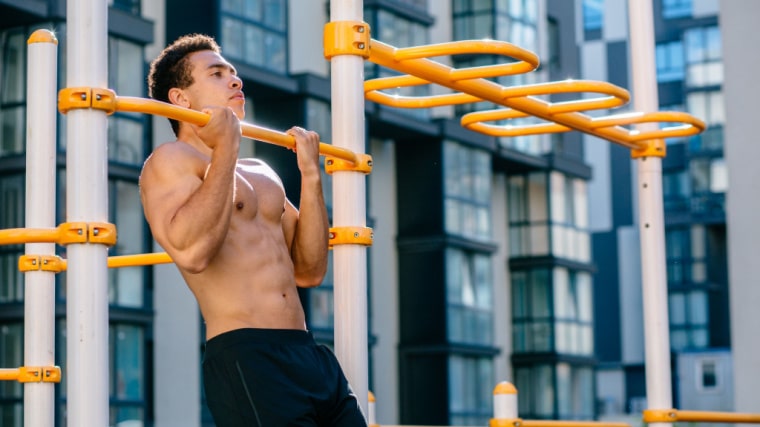
The straight-arm pushdown, sometimes called a stiff-arm pushdown or pulldown, is one the most effective movements to work just the lats because it is an isolation (single-joint) exercise. This allows you to really focus on the target body part with minimal assistance from other muscles.
Adding this exercise might just be the key to unlock new growth and a better mind-muscle connection. Here’s why and how to add it to your training plan.
- How to Do the Straight-Arm Pushdown
- Straight-Arm Pushdown Mistakes to Avoid
- How to Progress the Straight-Arm Pushdown
- Benefits of the Straight-Arm Pushdown
- Muscles Worked by the Straight-Arm Pushdown
- How to Program the Straight-Arm Pushdown
- Straight-Arm Pushdown Variations
- Frequently Asked Questions
How to Do the Straight-Arm Pushdown
As a single-joint exercise, the straight-arm pushdown is a fairly straightforward to perform. These types of movements typically require less coordination and technique than multi-joint exercises, but you still need to use proper form if you want the best results.
Step 1 — Set up at the Cable Station
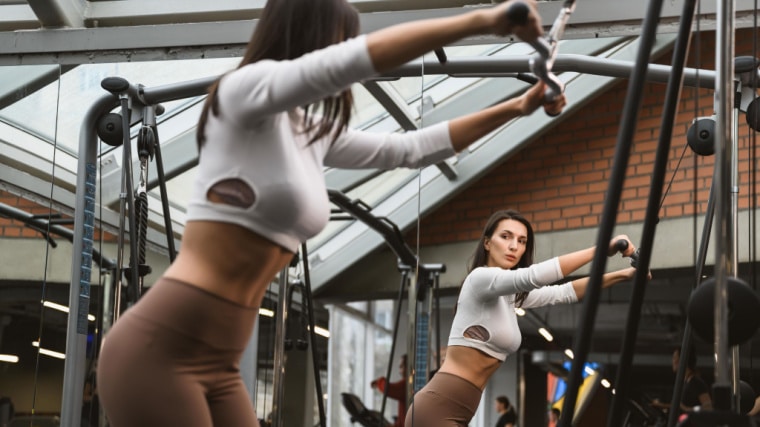
Set a cable pulley at the maximum height so that you can enjoy a full range of motion, and attach a straight or EZ-curl bar.
Grab the bar using a palms-down, shoulder-width grip, and fully extend your arms toward the pulley. Step back until the weight starts floating off the stack and you feel tension pulling you toward it. Lean forward at the waist and slightly bend your knees to adopt a stable position from which to pull. Your hands should be slightly above shoulder-height.
Form tip: Keep your shoulders down and your chest puffed up. This will diminish the stress on your shoulders and reduce interference from non-target muscles like your shoulders or traps.
Step 2 — Pull the Weight Down

Exhale and squeeze your lats as much as you can while driving the bar down towards your thighs. Keep your arms straight or slightly-bent for the duration of the lift. Nothing should move but your arms. Keep your wrists neutral, don’t allow them to curl down or bend back.
Form tip: Imagine you have an orange under each of your armpits and you’re squeezing them for their juice. This will help you recruit your back more and shift focus away from your arms.
Step 3 — Control the Stretch
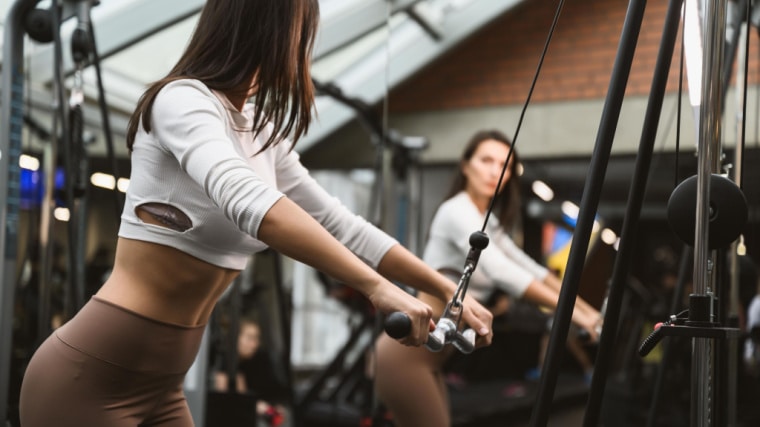
When the bar is nearly touching your legs, slowly reverse the motion and let your arms come up. Keep your torso still and don’t stand up straight at the weight comes up. Once you’re at the top of the range of motion and your back is fully stretched, repeat for the desired amount of reps.
Form tip: If you feel your arms overpowering your lats, and your triceps or shoulders fatigue before your back muscles, use a “false grip” by placing your thumb on top of the bar next to your fingers. This will reduce arm involvement.
Straight-Arm Pushdown Mistakes to Avoid
The straight-arm pushdown requires focus to reap all the benefits. You have to nail the technique if you want to progress safely, and that means avoiding these common mistakes.
Swinging the Weight
Ego should never have a place in the gym, especially not when doing an isolation movement. If you start using body English to move more weight, you’ll end up working your hips, abs, and arms more than your back. If you want to move more weight and use as many muscles as possible, then skip the straight-arm pushdowns and do some barbell rows.

Moreover, using momentum will put more stress on your connective tissue and joints, possibly causing injuries. (1)
Avoid it: Only your arms should move during the exercise, and they should only move at the shoulder, not the elbow. If you have to move anything else, it’s either because you used too much weight or that your initial set up (stance and body position) wasn’t stable enough. Reduce the weight, bend your knees a bit more, and widen your stance to lower your center of gravity and increase stability.
Using Your Arms
You might not expect it, but the long head of your triceps (posterior muscle of the arm) will assist your back during this exercise because it’s partially responsible for moving your arm at the shoulder joint. However, it should remain a lat-focused exercise.
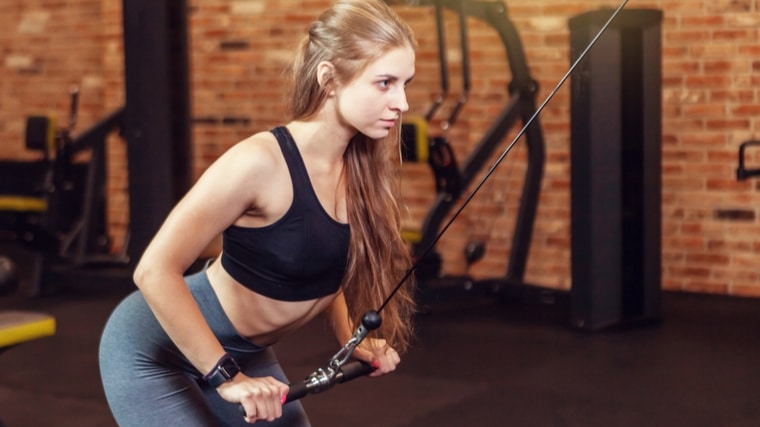
If you bend and extend your arms during the exercise, you’ll turn the exercise from a straight-arm pushdown into a wrongly-performed triceps pushdown, resulting in less muscle gains for each body part.
Avoid it: Don’t let your arms bend. Remember that it’s called a “straight-arm” movement and maintain the same elbow angle during the duration of the lift. To further reduce arm involvement, use a false grip by moving your thumbs on top of the bar near your fingers.
Going Too Heavy
Yes, there’s a recurring theme in this mistake session: do not chase weight. Keep the heavy weights and maximal efforts for the big compound exercises. If you use too much weight, you can end up compensating with other muscles and you’ll stop feeling the intended muscles, leading to less muscle growth. (2)
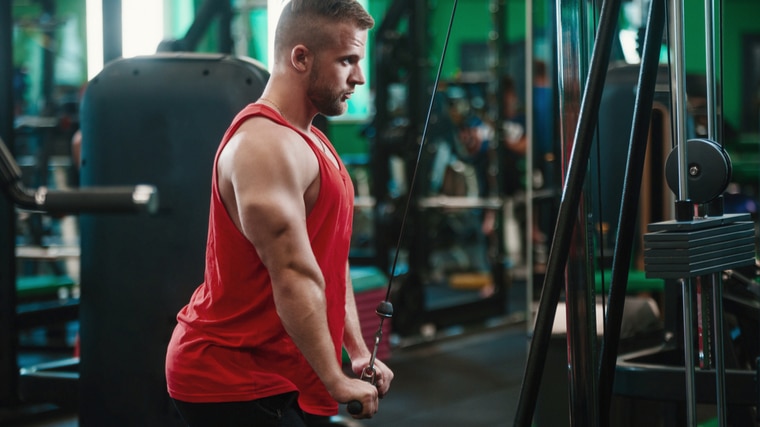
Avoid it: When you perform the exercise, if you stop feeling tension in your lats, it’s likely because other muscles have taken over. Reduce the weight immediately and double-check your stance, torso position, and arm angle.
How to Progress the Straight-Arm Pushdown
The cable station used for straight-arm pushdowns usually allows you to use very light or heavy weights, but that’s not always the case. Some pulleys have limited weights or other issues that affect your performance. In those cases, you can use progressions to either make the exercise easier or harder.
Resistance Band Straight-Arm Pushdown
Bands are versatile and easy to use. Strap a resistance band to a sturdy object at roughly head-height and perform the exercise as you would with a cable pulley. The band resistance starts very low and can be adjusted by standing closer or farther from the anchor point, which is perfect if you don’t yet feel confident enough to tackle more challenging resistance.
One benefit of bands is that the resistance curve increases during the range of motion — as the band is stretched, it becomes more challenging — which can be beneficial for you to feel your lats working. This is also a great variation if you don’t have access to a cable station.
Slow Tempo Straight-Arm Pulldown
Whether you can’t put more weight on the station or you just have trouble feeling the correct muscles working during this exercise, you can use a slower tempo (lifting and lower speed) to make to movement more challenging with lighter weights.
One great way to do this is by taking three to five seconds on the concentric phase (when you lift the weight) and three to five seconds for the eccentric (when you reverse the motion). This will make the exercise tremendously harder, increase the time under tension, and improve your mind-muscle connection as well.
Banded Dumbbell Pullover
If you’re an experienced lifter who already mastered the dumbbell pullover, which is itself a free-weight variation of the straight-arm pushdown, then you can take things to the next level. This is one of the most intense lat isolation exercises.
The problem with the basic dumbbell pullover is that there is little-to-no resistance at the top of the movement due to gravity’s limited effect on the weight. Strapping a band around the dumbbell, with an anchor point far behind your head, results in a continuous curve of resistance with a deep stretch and a hard peak contraction, resulting in a greater stimulus for muscle growth. (3)
Benefits of the Straight-Arm Pushdown
The straight-arm pulldown is very unique among back exercises because it allows you to zero-in on your lats without much fatigue or involvement from other back muscles.
Muscle Growth
Single-joint exercises are ideal for hypertrophy (muscle growth) because their purpose is to isolate a target muscle as much as possible. Isolation movement aren’t as effective for building strength because they weight used is limited, but if when it comes to talking strictly about muscle growth, they can be just as efficient as multi-joint exercises. (4)
Isolate Your Lats
If you’re a physique enthusiast and your lats are a weak point, the straight-arm pushdown is a perfect fix to bring them up to par. The fact that the straight-arm pushdown isolates the lats means you can really focus on them and correct any imbalances. You don’t have the risk of having your biceps, shoulders, or other back muscles taking over the movement.
The exercise also generates relatively less fatigue and is easier to perform than a multi-joint back exercise, meaning you could train it more often than other movements. The high-tension exercise is also better at increasing mind-muscle connection in your lats, something many lifters struggle with, but it can result in more muscle growth.
Muscles Worked by the Straight-Arm Pushdown
The straight-arm pushdown might be an isolation exercise, but the truth is that you can never isolate a single muscle. Let’s see what it trains.
Latissimus Dorsi
The lats are the biggest back muscle, giving it all its width. It goes from your hip bone to your humerus (arm bone) and attaches to your spine. This muscle has many functions including extending or flexing your torso, and moving or rotating the shoulder.
During the straight-arm pushdown, the lats are recruited when bringing your arms down toward your body’s midline. The straight-arm pushdown is one of the few back exercises that can perform this movement with limited involvement from the biceps.
Teres Major
This upper-back muscle goes from the humerus to the scapula, and it assists the lats in almost every function. The teres is heavily recruited during the straight-arm pushdown to stabilize your shoulder blades as your shoulders rotate and move through the range of motion..
Triceps Brachii
Even though the straight-arm pushdown primarily targets the back muscles, you’ll most likely feel your triceps burn during the exercise because they’re being worked statically, to maintain the straight-arm position. This posterior arm muscle consists of three heads (the long, lateral, and medial heads).
The long head, in particular, goes from the elbow to the scapula (shoulder blade) and it assists in moving your in toward your body’s midline, similar to the lats.
How to Program the Straight-Arm Pushdown
The straight-arm pushdown is ideally used for hypertrophy. In that regard, you should use repetition schemes conducive to muscle growth.
Moderate Weight, Moderate Repetition
This time-tested approach is the go-to for most bodybuilders. Three to four sets of eight to 12 repetitions will provide ample muscle tension and stimulus for optimal growth. This is a staple approach for a well-rounded back workout.
Low Weight, High Repetition
You can also use longer duration sets as a “finisher” for a serious burn and to practice technique. Two to three sets of 15 to 20 repetitions at the end of a session will encourage muscle growth as well, but will provide a different feeling from relatively heavier and lower rep training. Be sure to keep good posture and avoid swinging the weights as the reps get higher.
Straight-Arm Pushdown Variations
Once you’ve mastered the standard movement, you can try these variations to provide the same benefits to your body while creating a different stimulus. While these exercises are similar, the technique and movement differences will allow you to progress even further. (5)
Kneeling Straight-Arm Pushdown
This variation can be an excellent addition if you’re a taller lifter because it lets you use a full range of motion without worrying about the weight stack hitting the top of the pulley.
The kneeling position also provides more core and stability work because it’s harder to maintain and stabilize your balance. This increased core activation can be transferable to other exercises like the pull-up or general sports activities.
Dumbbell Pullover
This old school exercise is a favorite among classic bodybuilders. You only need a dumbbell and a bench, which is invaluable when you train during peak hours in a busy gym. You can either lie fully flat on a bench, or across it resting only your upper back on the bench which will increase the difficulty, thoracic (upper back) stretching, and core recruitment of the exercise.
The dumbbell pullover is also interesting because it changes the curve of resistance of the exercise — it emphasizes the lengthened contraction and the stretch of the muscle, but there’s almost no tension at the top. This can provide a completely novel stimulus which may trigger more growth.
Bent-Arm Barbell Pullover
This exercise is as old school as its dumbbell cousin and it follows the same general principles but this time, you’re using a barbell which changes your hand position and grip width.
The other key difference is that you’re not keeping your arms straight, but bent at around 90-degrees. The angle is maintained for the entire lift. This helps to put the lats into a nice, deep stretch. A few sets of practice and you’ll be able to appreciate the unique feeling of this classic movement.
Frequently Asked Questions
The standard grip with a straight-arm pushdown is around shoulder-width, but it’s more a question of comfort. Some lifters feel more natural pulling with a much wider grip, holding a lat pulldown bar attachment well-beyond shoulder-width. Other lifters use a rope handle and keep their hands almost touching each other during the exercise.
Use the grip width that allows you to feel the target muscles contract and stretch without causing any shoulder discomfort and without interference from other body parts. The most important part of the movement is maintaining a straight-arm position, not bending your arms throughout the lift.
Isolation exercises are often best performed later in a workout, especially when there is a significant stretch involved in the exercise, like the top position of the straight-arm pushdown. This helps to make sure your joints and muscles are fully warmed up to safely utilize the full range of motion.
You should do your heavier compound exercises, like rows or pull-ups, earliest in the workout when you’re fresh and can move the most weight, then finish the target muscle with the straight-arms pushdown at the end of the session.
However, you could sometimes use the this movement earlier in the session if you have trouble feeling your lats. Isolation exercises are great for “pre-exhausting” individual muscles and developing the mind-muscle connection.
Push Yourself to the Next Level
The straight-arm pushdown can help you define and reinforce your back whether you’re a beginner or an experienced lifter. If you’re looking to step up your back game, fill your shirts, and get stronger, it’s time to appreciate this rare isolation exercise.
References
- Faigenbaum AD, Myer GD. Resistance training among young athletes: safety, efficacy and injury prevention effects. Br J Sports Med. 2010 Jan;44(1):56-63. doi: 10.1136/bjsm.2009.068098. Epub 2009 Nov 27. PMID: 19945973; PMCID: PMC3483033.
- Calatayud J, Vinstrup J, Jakobsen MD, Sundstrup E, Brandt M, Jay K, Colado JC, Andersen LL. Importance of mind-muscle connection during progressive resistance training. Eur J Appl Physiol. 2016 Mar;116(3):527-33. doi: 10.1007/s00421-015-3305-7. Epub 2015 Dec 23. PMID: 26700744.
- Schoenfeld, Brad J. The Mechanisms of Muscle Hypertrophy and Their Application to Resistance Training. Journal of Strength and Conditioning Research: October 2010 – Volume 24 – Issue 10 – p 2857-2872 doi: 10.1519/JSC.0b013e3181e840f3
- Gentil P, Soares S, Bottaro M. Single vs. Multi-Joint Resistance Exercises: Effects on Muscle Strength and Hypertrophy. Asian J Sports Med. 2015 Jun;6(2):e24057. doi: 10.5812/asjsm.24057. Epub 2015 Jun 22. PMID: 26446291; PMCID: PMC4592763.
- Baz-Valle E, Schoenfeld BJ, Torres-Unda J, Santos-Concejero J, Balsalobre-Fernández C. The effects of exercise variation in muscle thickness, maximal strength and motivation in resistance trained men. PLoS One. 2019 Dec 27;14(12):e0226989. doi: 10.1371/journal.pone.0226989. PMID: 31881066; PMCID: PMC6934277.
Featured Image: ANRproduction / Shutterstock
The post How to Do the Straight-Arm Pushdown for a Wider Back appeared first on Breaking Muscle.







